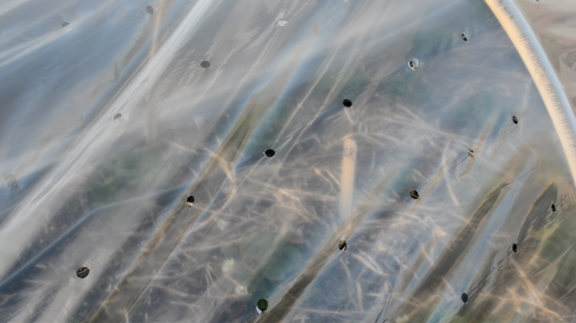Farm & Ranch
Easy, affordable cover extends growing season in home gardens

By: Kathleen Phillips
Writer: Kathleen Phillips, 979-845-2872, [email protected]
Contact: Dr. Joe Masabni, 979-324-1244, [email protected]
COLLEGE STATION — A technique used by commercial growers to protect tender crops from harmful cold temperatures may be an affordable option for home growers as well, according to Dr. Joe Masabni, Texas A&M AgriLife Extension Service vegetable specialist.
“I’ve been working with strawberry producers, and we’ve found that using plastic covers to form small tunnels over the row is definitely a great tool to protect the plant during those occasional days or weeks when we have a severe freeze,” Masabni said. “Why not show that it can be done for the homeowner,using the same material that the commercial growers have?”
Masabni used a clear, 6 millimeter plastic that is 6 feet wide and has perforations about 4 inches apart in a grid pattern. He said that easily covers the typical 4-foot wide raised bed most people use for home gardens. For a 15-foot long bed, he used about $2 worth of a 500-foot roll of plastic.
He bent four PVC pipes – at a cost of $10 – from side to side across the bed. He used eight snap clamps, which cost about $10 dollars, to secure the plastic to the PVC pipes. Some U-shaped garden staples may be needed to keep the plastic from blowing too much and to further secure the warm air inside.
“So, for about $22, I can protect my raised bed from those nights that become severely cold,” Masabni said. “For strawberries, for example, the idea is to protect the flowers. The leaves can tolerate a lot of cold nights, even 32 or 30 degree temperatures. In Texas, we planted in September, and we already have fruits and flowers on them in mid-December. If we can protect them on those occasional very cold nights, we can be harvesting throughout the winterand get an earlier harvest in the spring.”
He said the plastic, pipes and snaps should last for several years of repeated winter use if taken care of, making such a system even more affordable over time.
“And the beauty of the perforated plastic is that you don’t have to worry about opening up on a warm sunny day because the prepunched holes would let the extra heat vent out, while during the night it traps air inside tokeep the plants warm,” Masabni added. “Set it and forget.”
Previous tests Masabni has done on the plastic-covered crops as far north as Kentucky showed that the temperature inside the plastic-covered row is always 10-20 percent higher than outside.
Hesuggested that rows may be covered until around March 1, depending on the weather forecast in a given year, or until the last chance of severe frost passes.
Another benefit is that other less cold-tolerant crops, such as tomatoes, can be planted earlier under such a system, he said.
“I have planted tomatoes mid-February whereas usually they are planted around March 15 in Brazos County,for example.”
The snap clamps on the plastic sheeting are easily removable for harvesting, Masabni said. “You can open a couple or three on one side and then harvest and tend to the crop as needed.”
-30-
Farm & Ranch
Hazards of Backyard Poultry

By Barry Whitworth, DVM
Having backyard poultry is a popular agriculture enterprise. According to the United States Department of Agriculture, 0.8 percent of all households in the United States have chickens. People keep chickens for a variety of reasons with table eggs being one of the more common reasons.
Unfortunately, some of these poultry producers are not aware of the hazards that come with keeping poultry because many times they carry pathogens but appear healthy.
Chickens are carriers of several zoonotic diseases. These are diseases that can be passed from animals to humans. According to a recent survey in Pennsylvania, a majority of backyard poultry producers were aware of the dangers of avian influenza. However, this study also revealed that far fewer producers were aware of the risk of possible exposure to Salmonella and Campylobacter.
The lack of knowledge about the hazards of raising poultry likely contributes to the continued issues of Salmonella outbreaks associated with backyard poultry. In 2023, the Centers for Disease Control and Prevention reported 1,072 illnesses of Salmonella linked to backyard poultry, and 272 of those patients required hospitalization. Oklahoma reported 43 individuals with the disease.
To read more, pick up a copy of the April issue of NTFR magazine. To subscribe by mail, call 940-872-5922.
Farm & Ranch
Ag Elsewhere: Wyoming

By Tressa Lawrence
Babies are tucked away in every nook and cranny. Many ranchers across Wyoming have baby animals popping up all over this time of year.
Farm & Ranch
Ag Elsewhere: Montana

By Lindsey Monk
Another load of grain in to keep feeding the calves until the green grass can really start popping.
-

 Country Lifestyles1 year ago
Country Lifestyles1 year agoScott & Stacey Schumacher: A Growth Mindset
-

 Equine7 months ago
Equine7 months agoThe Will to Win
-

 Country Lifestyles7 years ago
Country Lifestyles7 years agoStyle Your Profile – What your style cowboy hat says about you and new trends in 2017
-

 Country Lifestyles4 years ago
Country Lifestyles4 years agoAmber Crawford, Breakaway Roper
-

 HOME7 years ago
HOME7 years agoGrazing North Texas – Wilman Lovegrass
-

 Country Lifestyles7 years ago
Country Lifestyles7 years agoDecember 2016 Profile, Rusty Riddle – The Riddle Way
-

 Country Lifestyles8 years ago
Country Lifestyles8 years agoJune 2016 Profile – The man behind the mic: Bob Tallman
-

 Outdoor9 years ago
Outdoor9 years agoButtercup or Primrose?






